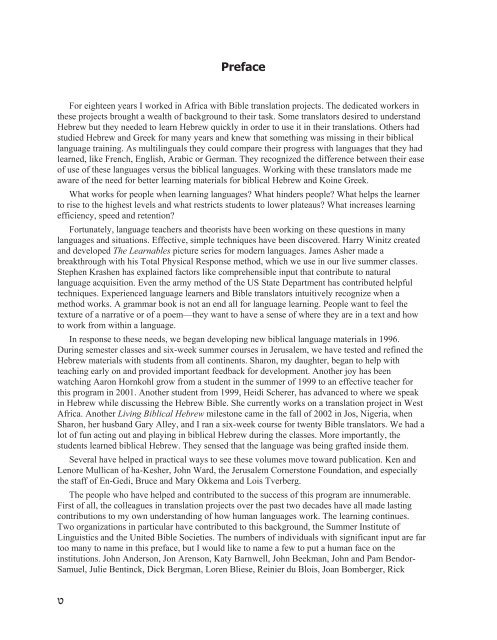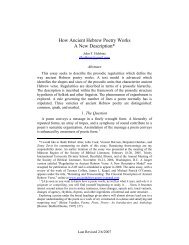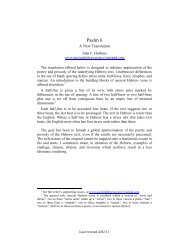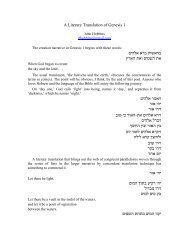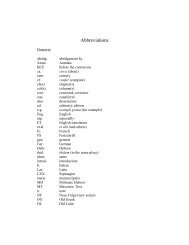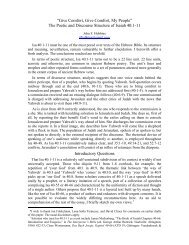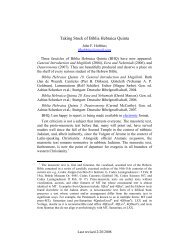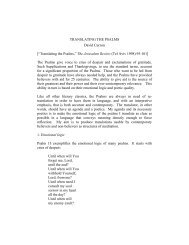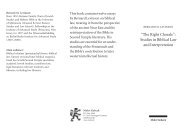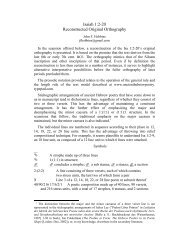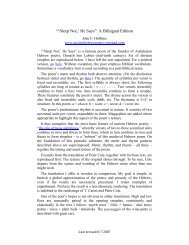Living Biblical Hebrew - Ancient Hebrew Poetry
Living Biblical Hebrew - Ancient Hebrew Poetry
Living Biblical Hebrew - Ancient Hebrew Poetry
Create successful ePaper yourself
Turn your PDF publications into a flip-book with our unique Google optimized e-Paper software.
PrefaceFor eighteen years I worked in Africa with Bible translation projects. The dedicated workers inthese projects brought a wealth of background to their task. Some translators desired to understand<strong>Hebrew</strong> but they needed to learn <strong>Hebrew</strong> quickly in order to use it in their translations. Others hadstudied <strong>Hebrew</strong> and Greek for many years and knew that something was missing in their biblicallanguage training. As multilinguals they could compare their progress with languages that they hadlearned, like French, English, Arabic or German. They recognized the difference between their easeof use of these languages versus the biblical languages. Working with these translators made meaware of the need for better learning materials for biblical <strong>Hebrew</strong> and Koine Greek.What works for people when learning languages? What hinders people? What helps the learnerto rise to the highest levels and what restricts students to lower plateaus? What increases learningefficiency, speed and retention?Fortunately, language teachers and theorists have been working on these questions in manylanguages and situations. Effective, simple techniques have been discovered. Harry Winitz createdand developed The Learnables picture series for modern languages. James Asher made abreakthrough with his Total Physical Response method, which we use in our live summer classes.Stephen Krashen has explained factors like comprehensible input that contribute to naturallanguage acquisition. Even the army method of the US State Department has contributed helpfultechniques. Experienced language learners and Bible translators intuitively recognize when amethod works. A grammar book is not an end all for language learning. People want to feel thetexture of a narrative or of a poem—they want to have a sense of where they are in a text and howto work from within a language.In response to these needs, we began developing new biblical language materials in 1996.During semester classes and six-week summer courses in Jerusalem, we have tested and refined the<strong>Hebrew</strong> materials with students from all continents. Sharon, my daughter, began to help withteaching early on and provided important feedback for development. Another joy has beenwatching Aaron Hornkohl grow from a student in the summer of 1999 to an effective teacher forthis program in 2001. Another student from 1999, Heidi Scherer, has advanced to where we speakin <strong>Hebrew</strong> while discussing the <strong>Hebrew</strong> Bible. She currently works on a translation project in WestAfrica. Another <strong>Living</strong> <strong>Biblical</strong> <strong>Hebrew</strong> milestone came in the fall of 2002 in Jos, Nigeria, whenSharon, her husband Gary Alley, and I ran a six-week course for twenty Bible translators. We had alot of fun acting out and playing in biblical <strong>Hebrew</strong> during the classes. More importantly, thestudents learned biblical <strong>Hebrew</strong>. They sensed that the language was being grafted inside them.Several have helped in practical ways to see these volumes move toward publication. Ken andLenore Mullican of ha-Kesher, John Ward, the Jerusalem Cornerstone Foundation, and especiallythe staff of En-Gedi, Bruce and Mary Okkema and Lois Tverberg.The people who have helped and contributed to the success of this program are innumerable.First of all, the colleagues in translation projects over the past two decades have all made lastingcontributions to my own understanding of how human languages work. The learning continues.Two organizations in particular have contributed to this background, the Summer Institute ofLinguistics and the United Bible Societies. The numbers of individuals with significant input are fartoo many to name in this preface, but I would like to name a few to put a human face on theinstitutions. John Anderson, Jon Arenson, Katy Barnwell, John Beekman, John and Pam Bendor-Samuel, Julie Bentinck, Dick Bergman, Loren Bliese, Reinier du Blois, Joan Bomberger, Rick


